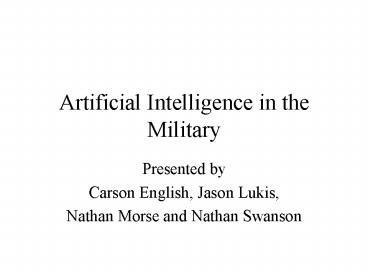Artificial Intelligence in the Military PowerPoint PPT Presentation
1 / 27
Title: Artificial Intelligence in the Military
1
Artificial Intelligence in the Military
- Presented by
- Carson English, Jason Lukis,
- Nathan Morse and Nathan Swanson
2
Overview
- History
- Neural Networks
- Automated Target Discrimination
- Tomahawk Missile Navigation
- Ethical issues
3
History
- 1918 first tests on guided missiles
- 1945 Germany makes first ballistic missile
- 1950 AIM-7 Sparrow
- fire-and-forget
4
(No Transcript)
5
History
- 1973 remotely piloted vehicles (RPVs)
- Used to confuse enemy air defenses
- 1983 tomahawk missile first used by navy
- Uses terrain contour matching system
- 1983 Reagan make his famous star wars speech
- 1988 U.S.S. Vincennes mistakenly destroys
Iranian airbus due to autonomous friend/foe
radar system
6
History
- 1991 Smart bombs used in Gulf War to
selectively destroy enemy targets - Praised for its precision and effectiveness
7
Neural Networks
- Inspired by studies of the brain
- Massively parallel
- Highly connected
- Many simple units
8
Structure of a neuron in a neural net
9
Neural net with three neuron layers
10
Three Main Neural Net Types
- Perceptron
- Multi-Layer-Perceptron
- Backpropagation Net
11
Perceptron
12
Multi-Layer-Perceptron
13
Backpropagation Net
14
Areas where neural nets are useful
- pattern association
- pattern classification
- regularity detection
- image processing
- speech analysis
- optimization problems
- robot steering
- processing of inaccurate or incomplete inputs
- quality assurance
- simulation
15
Limits to Neural Networks
- the operational problem encountered when
attempting to simulate the parallelism of neural
networks - inability to explain any results that they obtain
16
Automated Target Discrimination
As researched by the Computational
NeuroEngineering Laboratory in Gainsville, FL
- SAR (Synthetic Aperture Radar)
- CFAR (Constant False Alarm Rate)
- QGD (Quadratic Gamma discriminator)
- NL-QGD (multi-layer perceptron)
- Example
- Results
17
Synthetic Aperture Radar
- Data collection for ATD
- Self-illuminating imaging radar
- Creates a height map of a surface
- Maintains spatial resolution regardless of
distance from target - Can be used day and night regardless of cloud
cover
18
Picture of SAR rendering
19
Two Constant False Alarm method for determining
targets
20
Quadratic Gamma discrimination
21
Non Linear QGD
22
Example
23
Results
- After training, all three discriminators were run
on a data set representing 7km2 of terrain.
Target detection threshold was set to 100. - CAFR resulted in 4,455 false alarms.
- QGD resulted in 385 false alrams.
- NL-QGD resulted in 232 false alarms.
24
Tomahawk Missile Navigation
- Missile contains a map of terrain
- Figures out its current position from percepts
(radar altimeter) - Uses a modified Gaussian least square
differential correction algorithm, a step size
limitation filter, and a radial basis function
25
Weight matrix
Radial Basis Function
Gaussian Least Square Correction
Necessary Condition
Sufficient Condition
Step size limitation filter
Tolerence error 10-8
26
Ethics
- Accountability
- Legal
- Political
- Example Aegis defense system shoots down an
Iranian Airbus jetliner in 1988 - Use of AI in warfare
- Ethics of Research and Development
- Potential uses
- Military Funding of AI
- Passing of the blame just doing my job
27
Sources
- Target Discrimination in Synthetic Aperture
Radar (SAR) using Artificial Neural Networks
Jose C. Principe, Munchurl Kim, John W. Fisher
III. Computational NeuroEngineering Laboratory.
EB-486 Electrical and Computer Engineering
Department. University of Florida. - Sandia National Laboratories. http//www.sandia.g
ov/radar/sar.html - Jet Propulsion Laboratory California Institute
of Technology. http//southport.jpl.nasa.gov/desc
/imagingradarv3.html - Wageningen University, The Netherlands.
http//www.gis.wau.nl/sar/sig/sar_intr.htm

